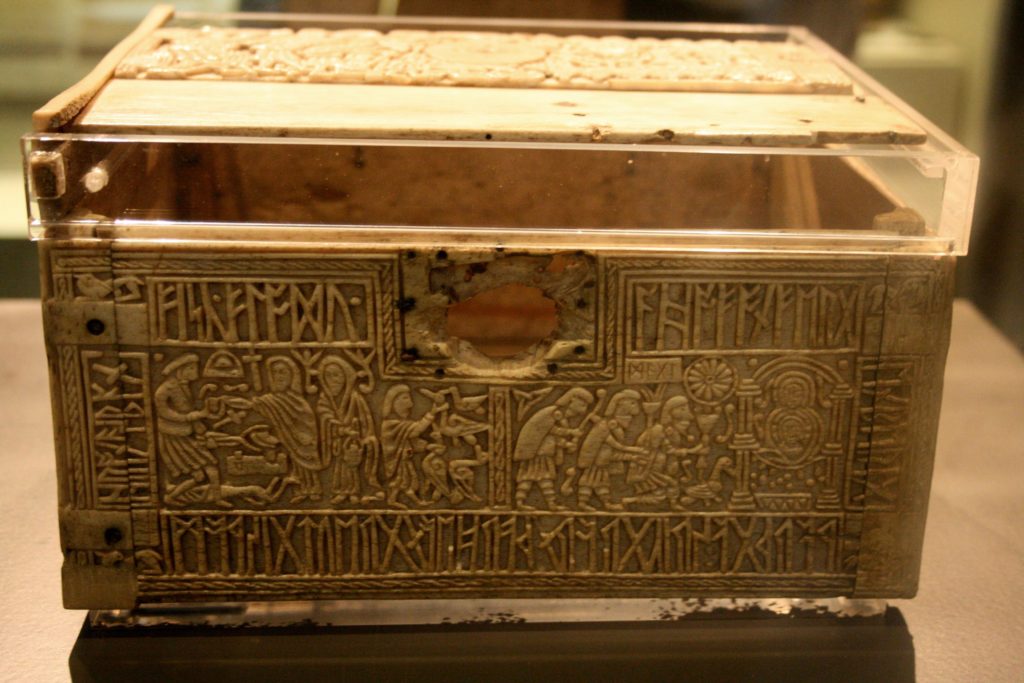In preparation for the V International Congress of the John Gower Society in Scotland this summer, I’ve been exploring a twisted little tale from John Gower’s Confessio Amantis known as the “Tale of Albinus and Rosemund.” The story sees Albinus, the newly crowned king of Lombardy, married to Rosemund, daughter of the previous king whom Albinus has slain. Despite the couple’s love for each other, Albinus tricks his wife into drinking from a cup that has been fashioned from the skull of her late father.

Having been so elaborately adorned with precious stones atop a gold pedestal, the vessel no longer resembles a skull, and Albinus bids his bride, “Drink with thi father, Dame.”[1] Rosemund drinks. Albinus then reveals his cruelty, and Rosemund proceeds to have him murdered.
The tale made me wonder about the extent to which skulls have been used as drinking cups and whether the practice existed in the medieval period, perhaps even in Britain. I wondered, too, whether any remnants remained, particularly any as dazzling as the one Albinus debuts to Rosemund’s horror.
Vikings might seem the likely culprits, but Vikings did not, it seems, drink from the skulls of their enemies despite how deeply ingrained the association has become in popular culture. That said, the Poetic Edda contains a reference to cups created from skulls in the story of Wayland the Smith, who seeks vengeance against the king for his violent imprisonment. In the Old Norse narrative, Wayland kills the king’s two young sons and gifts their silver-gilded skulls to him, their eyes gruesomely replaced with glittering jewels.

Early Britons, however, did use skulls as crockery.
In 1987, researchers discovered cups crafted from human skulls in a cave in Somerset, England. The three cups, made from the skulls of two adults and a three-year-old child, were re-examined in 2011 and dated to 14,700 BP. As reported in The Guardian, “Detailed examination of 37 skull fragments and four pieces of jaw using a 3D microscope revealed a common pattern of hard strikes followed by more finessed stone tool work that turned a freshly decapitated head into a functional cup or bowl.”[2]
Markings on the bones suggest that the bodies were butchered for meat before the heads were severed, but there is no physical evidence to suggest that the skulls served as trophies for those who repurposed them. Rather than being enemies, they may have died of natural causes, and it’s possible those who survived them intentionally preserved their skulls as a way of honoring them in death. But it is also possible that the skulls belonged to enemies according to Dr. Bruno Boulestin, an archaeologist at the University of Bordeaux in France, who stated that “in ‘nine out of 10’ societies known from historical or ethnographic records, skulls were removed as trophies for the purpose of humiliating the enemy.”[3]

Whatever the circumstances, the cups were by no means haphazardly made, and the physical evidence, including engraving on the bones, appears to be ritualistic, rather than simply cannibalistic. Based on research by scientist Dr. Silvia Bello, the Natural History Museum in London explains, “The painstaking preparation of the skull-cups suggests that they were prepared for a special purpose rather than just for nutrition. After all, it would have been much quicker and easier to just smash the skull the access the fatty brain inside.”[4] The craftmanship, therefore, is deliberate and thorough, even if the goblets themselves are not as glamorous as the one depicted in Gower’s tale.
At nearly 15,000 years old, the cups found in Gough’s Cave obviously predate the medieval period, but Wales, in fact, retains a skull cup originating in the Middle Ages, as it was made from the remains of a 6th-century monk and bishop known as Saint Teilo. Set in silver atop a silver stand, the cup now sealed behind glass at Llandaf Cathedral was once used for healing purposes, apparently as recently as the 1940s. The water from Saint Teilo’s well, also located in Wales, was said to be most effective against chest ailments, especially when drunk from Saint Teilo’s skull and even more so if distributed to the sick by the hands of the skull’s keeper. Like other saintly relics, the cup is attributed with healing properties, largely separating it from the gore associated with dismemberment.

Returning to the skull cup from which Rosemund drinks, I have yet to render my verdict on the vessel’s meaning but see it as a vehicle signifying both consumption and catharsis not unlike these others from early Britain. After drinking from the body of her father, Rosemund releases her rage in retaliation against her husband’s tyranny, embodying the conqueror and effectively ending Albinus’s reign.
Emily McLemore, Ph.D.
Department of English
University of Notre Dame
[1] John Gower, Confessio Amantis, The Project Gutenberg eBook of Confessio Amantis, line 2551, 11 Aug 2022.
[2] Ian Sample, Cheddar cave dwellers ate their dead and turned their skulls into cups, The Guardian, 16 Feb 2011.
[3] Michael Balter, Ancient Britons Used Skulls as Cups, Science, 16 Feb 2011.
[4] Lisa Hendry, The Cannibals of Gough’s Cave, Natural History Museum, accessed 23 May 2023.
